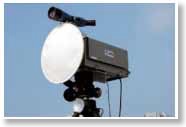Regulatory Barriers to >95 GHz Wireless Technology
While ITU has spectrum allocations as high as 275 GHz and claims jurisdiction to 3000 GHz, FCC – and probably all nation spectrum regulators (“administrations” in ITU jargon) – have no specific rules, licensed or unlicensed, for frequencies greater than 95 GHz – with the minor exception of provisions for radio amateurs and ISM (e.g. microwave ovens) in a few small segments. This lack of rules and quick market access probably inhibits capital formation for innovative wireless products because it raises unusual and unquantifiable “regulatory risks”
The commentators of Fox News repeatedly comment on the “war on coal” and the “war on religion”. Well, the “war on millimeter (mmW) wave technology” at FCC is just as real and easier to document, although it is no doubt unintentional. There are 3 proceedings at FCC that document FCC’s present disinterest/apathy towards commercial use of cutting edge microwave technology, even as other national competitors advance in this area due to better collaboration between indusrial policy and spectrum policy.
The current situation of US regulation >95 GHz needs the urgent attention of communications technologists, especially researchers and firms dealing with millimeter wave technology. The lack of “service rules” beyond 95 GHz makes regular commercial licensed or unlicensed mmW use impossible. This in turn greatly complicates capital formation for such technology because VCs can easily find other technology to invest in that does not involve making a prominent communications lawyer member a member of your family for several years and paying his children’s college tuition while at the same time the entrepreneur has no access to market and bleeds red ink.
Sadly, with the exception of the IEEE 802 LAN/MAN Standards Committee (the techies behind Wi-Fi standards), Boeing, and the more obscure (at least in FCC circles) Battelle Memorial Institute and the rather obscure Radio Physics Solutions, Inc., no commercial interests have filed comments with FCC on 3 key issues blocking capital formation for technology above 95 GHz and by extension hindering US competitiveness in advanced radio technology.
The 3 dockets involved are:
- Docket 10-236 which as was supposed to encourage experimentation had the apparently unintended effect of complicating millimeter waver research by forbidding, for the first time and without an explanation, all experimental licenses in bands with only passive allocations – independent of whether there was any adverse impact on passive systems. Many mmW bands have only passive allocations and it is difficult a and expensive to avoid them in initial experiments with new technology and it is not important if there is no passive use near the experiment than could get interference. Since the text of the Report and Order contradicts itself on this issue, the simplest explanation is that a sentence was put in the wrong section. Your blogger filed a timely reconsideration petition when he noticed this 2 days before the deadline and that had been supported by Battelle and Boeing and has been opposed by none. But FCC doesn’t necessarily react in a timely way, specially when incentive auctions are very distracting and staffing is low, unless there are multiple expressions of concerns, preferably from corporate America.
- Docket 13-259 deals with the IEEE-USA petition seeking timely treatment of new technology proposals for this green field spectrum >95 GHz under the terms of 47 USC 157, although any clear statement from FCC on how to get timely decisions on such spectrum would be useful.
- Docket 13-84 has proposed updating the Commission’s RF safety rules. The rules currently only have numeric limits up to 100 GHz – the upper limit of the standard they were based on when they were last updated almost 2 decade ago – but the new proposals are silent on numeric limits above 100 GHz even though the standard that is now the base of the regulations now goes to 300 GHz! This lack of a specific safety standard above 100 GHz adds even more to the regulatory uncertainty of those interested in mmW technology. With today’s mmW technology, the specific numeric standard doesn’t really matter much because exposures will be low. But this proposal to leave ambiguity for mmW systems can be very damaging. Battelle has proposed one way to deal with a specific standard. Others interested in mmW technology should either support it or propose an alternative.
- RM-11713 A specific proposal from Battelle for rules to allow a licensed point-to-point service at 102-109.5 GHz (between 2 bands allocated for only passive use).
Technology above 95 GHz may not be available at retailers like Walmart and Radio Shack today, but it is not “blue sky” either. (Wi-Fi was not a household word – even even yet named – when FCC created the rules for it in 1985.) The pictures below shows a 120 GHz systems used 6 years ago and a recent German 237 GHz experiment.
Spectrum policy need not be a “spectator sport”. Wireless innovators should realize that access to capital for R&D depends on real business plans and that includes timely spectrum access in the case of wireless technologies. Listed above are 4 FCC proceedings that deal with technologies >95 GHz. The technical community has been oddly silent on all 4. You may not agree with all of them or even some of them, but the proper way to deal with that is make your voice known and tell FCC and/or you national spectrum regulator what you think about policies at the upper end of the spectrum.
vox populi, vox dei
Japanese 120 GHz system used at 2008 Beijing Olympics
German 237 GHz System exceeding 100 Gbits/s
( An experiment probably not permitted in USA under the terms of FCC’s recently revised experimental license rules)


